亚洲小爪水獭(tǎ)Asian small-clawed otter
1. 分类Taxonomy(IUCN)
食肉目Carnivora
小爪水獭属Aonyx
亚洲小爪水獭Aonyx cinereus(Illiger,1815);英文名Asian small-clawed otter、Oriental Small-clawed Otter、Small-clawed Otter
2. 保护级别Conservation assessment
l 中国国家二级重点保护物种(图1)
National second class key protected species of China (Fig.1)
l IUCN红色名录易危物种(图2)
Vulnerable (VU) species on IUCN Red List (Fig. 2)
l CITES(华盛顿公约/濒危野生动植物种国际贸易公约)附录Ⅰ
Species on CITES appendix Ⅰ

图1. 亚洲小爪水獭为我国国家二级重点保护物种(来源国家林业和草原局/国家公园管理局)
Figure 1. Asian small-clawed otter as one of national second class key protected species of China (origin: forestry.gov.cn)

图2. 亚洲小爪水獭IUCN红色名录保护级别(来源IUCN)
Figure 2. The assessment level of Asian small-clawed otter on IUCN red list (origin: IUCN)
3. 形态特征Physical Description
亚洲小爪水獭是世界上体型最小的水獭物种,比其它水獭更矮胖。身体长度为40-61厘米;尾巴长度29-35厘米;体重2-4千克。
水獭类的动物有一层很密的绒毛,每平方厘米可以达到约7万根;还有一层长长的刚毛,当它们在水里时可以隔绝空气。
亚洲小爪水獭头部、背部、四肢和尾巴为均一的暗褐色,脸颊下部、喉部和胸部为灰白色(图3)。
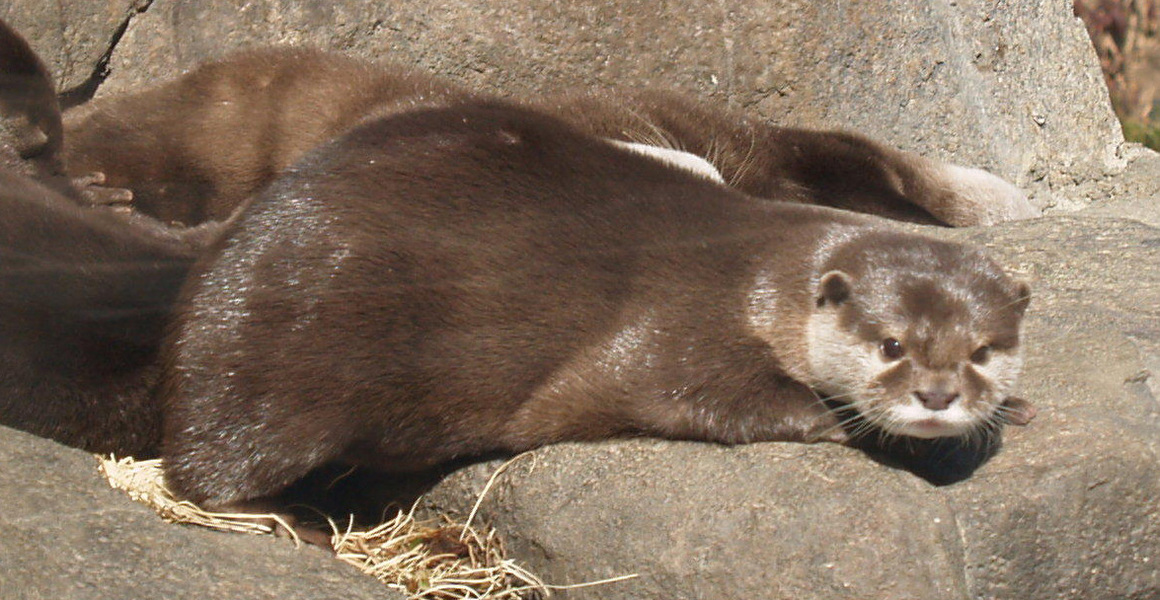
图3. 亚洲小爪水獭实体图(作者James Dowling-Healey;来源Animal Diversity Web)
Figure 3. Asian small-clawed otter (contributor: James Dowling-Healey; origin: Animal Diversity Web)
它们脸上有长而密的触须;头两侧有又小又圆的耳朵,比其它水獭更圆;眼睛相对较大(与其它水獭的眼睛与头部大小的比例相比)。水獭类动物在水下时,耳朵与鼻孔的瓣膜都会自动关闭,防止水进入(图4)。
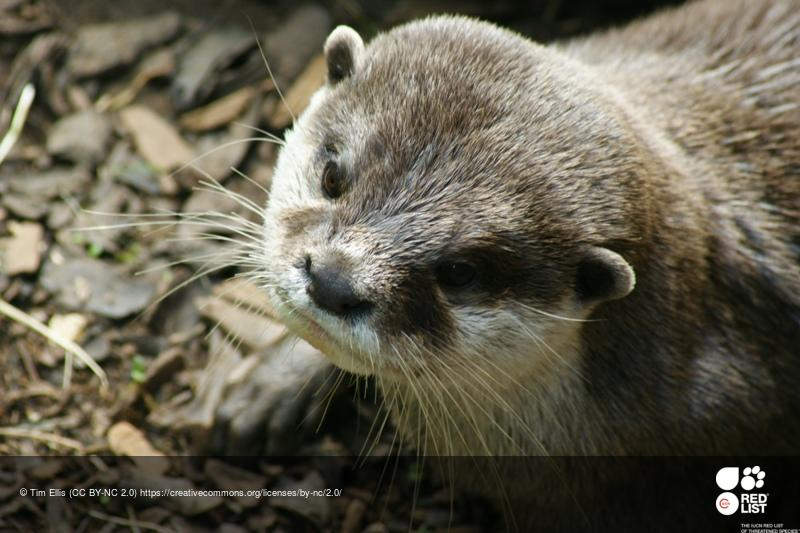
图4. 亚洲小爪水獭头部示意图(作者Tim Ellis,来源IUCN)
Figure 4. The head of Asian small-clawed otter (contributor: Tim Ellis; origin: IUCN)
前爪的趾短粗有力,也很灵活,并且趾的末端有小小的已经退化的爪,在球根状的趾末端像枚木钉一样(图5、6)。它们的前爪可以挖泥土和抬起岩石,也可以用来捕食。
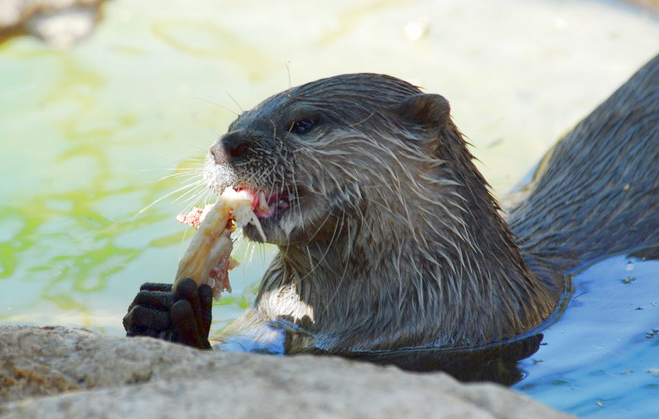
图5. 亚洲小爪水獭使用前爪取食示意图(作者David Blank;来源Animal Diversity Web)
Figure 5. An Asian small-clawed otter using its forepaws to eat (contributor: David Blank; origin: Animal Diversity Web)
尾基部宽厚,但尾端骤然变尖,背腹两侧呈扁平状。
头骨小、短且宽;虽然牙齿大小与欧亚水獭(Lutra lutra)和江獭(Lutrogale perspicillata)的相似,但头骨明显更小(小于9厘米)。小爪水獭的最后的两颗上牙更大,其形状非常适合压碎螃蟹和其他硬壳猎物的外骨骼。
在野外远距离见到时,可能较难与其近缘物种欧亚水獭相区分,小爪水獭的体型远小于后者(图6)。
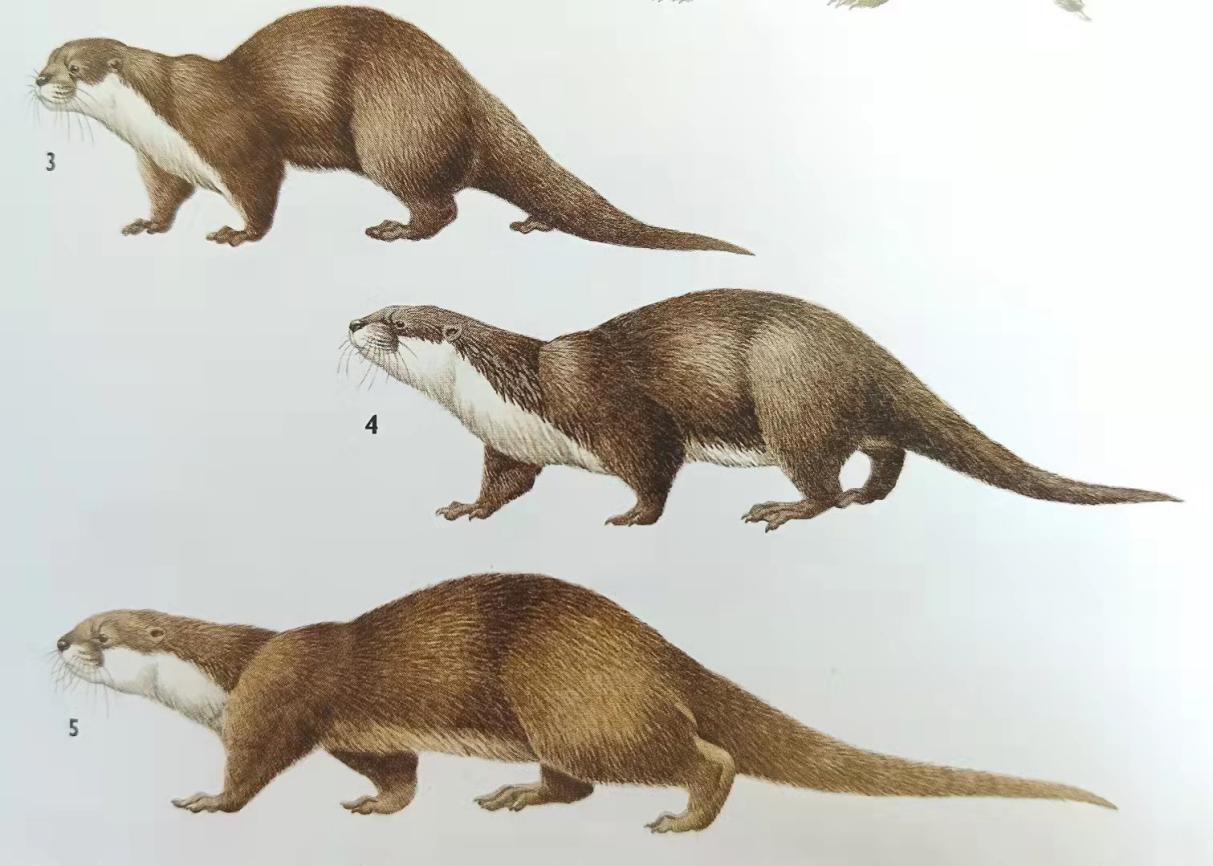
图6. 三种中国水獭对比图(来源《中国兽类野外手册》);3:亚洲小爪水獭;4:欧亚水獭;5:江獭
Figure 6. Comparing among the three otter species distributed in China (origin: A Guide to the Mammals of China); 3: Asian small-clawed otter; 4: Eurasian otter; 5: smooth-coated otter
The Asian small-clawed otter is the smallest otter species in the world and is stocky than other otters. Body length is 40-61 cm, tail is 29-35 cm long, and weigh is 2-4 kg.
Otters have a thick coat of fluff hair, with the density up to about 70,000 hairs per square centimeter, and a long layer of bristles that insulate air when they're in the water.
The Asian small-clawed otter is uniformly dark brown on the head, back, limbs and tail, and grayish white on the lower cheeks, throat and chest (Fig. 3).
They have long, dense tentacles on their faces. They have small, round ears, which are rounder than other otters, and they have relatively larger eyes (compared to the size of other otters' eyes relative to their head). Otters have valves in their ears and nostrils that automatically close underwater, preventing water from entering (Fig. 4).
The toes of the fore-paws are short, strong and flexible, with small, degenerated claws at the ends that resemble wooden spikes at the bulbous ends (Fig. 5, 6). Their front paws can be used to dig through dirt and lift rocks, as well as to hunt.
The caudal base is broad and thick, but the caudal end suddenly becomes sharp, and the dorsal and ventral sides are flattened.
The skull is small, short and wide. While the teeth are similar in size to those of Eurasian otters (Lutra Lutra) and smooth-coated otters (Lutrogale perspicillata), the skull is significantly smaller (less than 9cm). The last two upper teeth of the small-clawed otter are larger and are perfectly shaped to crush the exoskeletons of crabs and other hard-shelled prey.
When seen from a distance in the wild, it may be difficult to distinguish it from its close relative, Eurasian otter, and small-clawed otter is much smaller than Eurasian otter (Fig.6 ).
4. 地理分布Geographic Range
全世界主要分布区域:亚洲的热带与亚热带地区,包括南亚与东南亚,并延伸至喜马拉雅山脉南麓与我国华南。
分布国家:中国、尼泊尔、不丹、孟加拉国、印度、老挝、缅甸、柬埔寨、越南、泰国、马来西亚、新加坡、菲律宾、文莱、印尼(图7)。
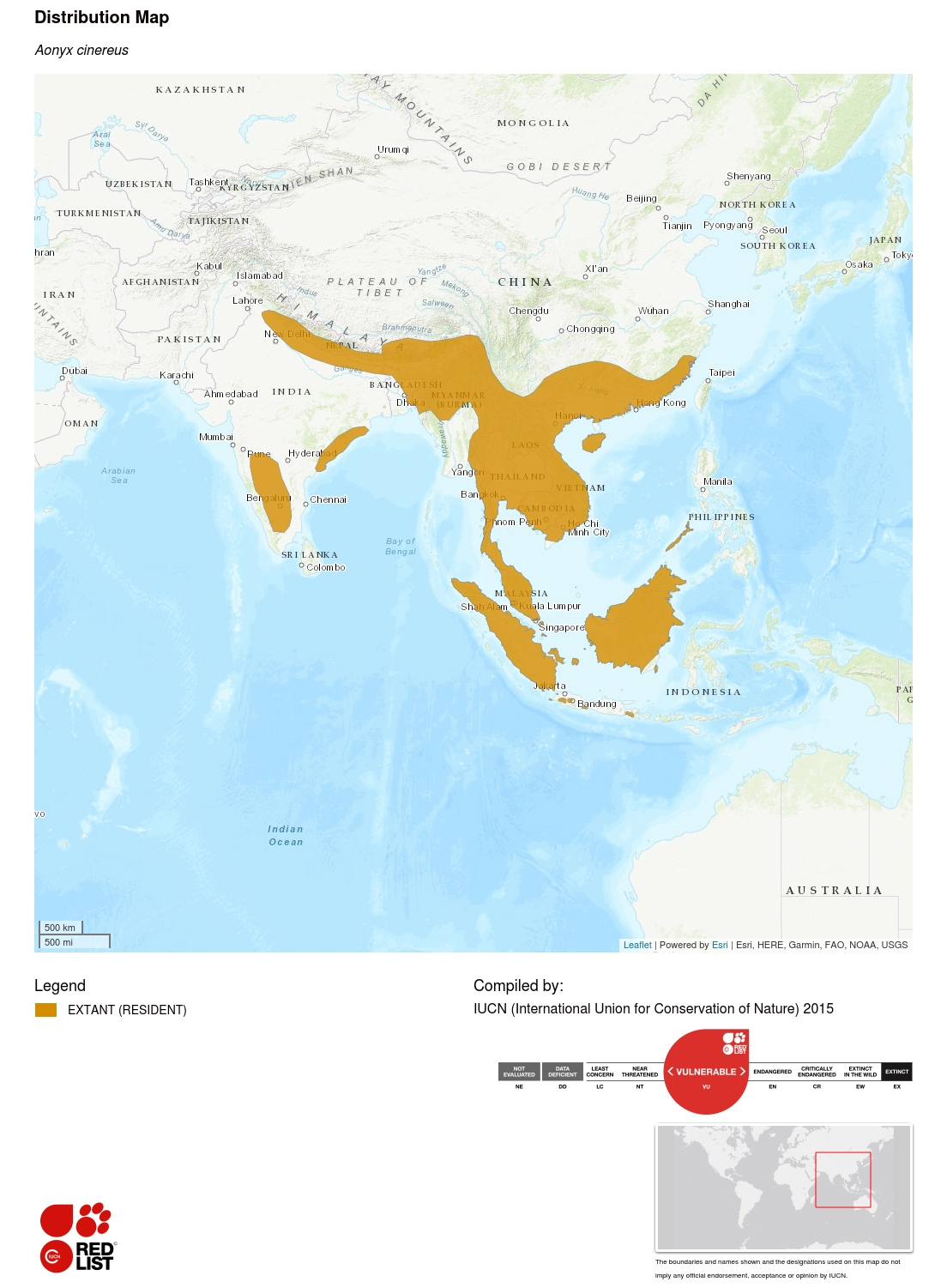
图7. 小爪水獭世界范围地理分布(来源IUCN)
Figure 7. Geographic range of Asian small-clawed otter around the world (origin: IUCN)
我国分布:在我国,小爪水獭曾经广泛分布于南方与西南多个省区,包括福建、广东、广西、贵州、云南、四川、西藏、海南和台湾(图8),但近年来仅在云南西部的少数地点有确认记录。
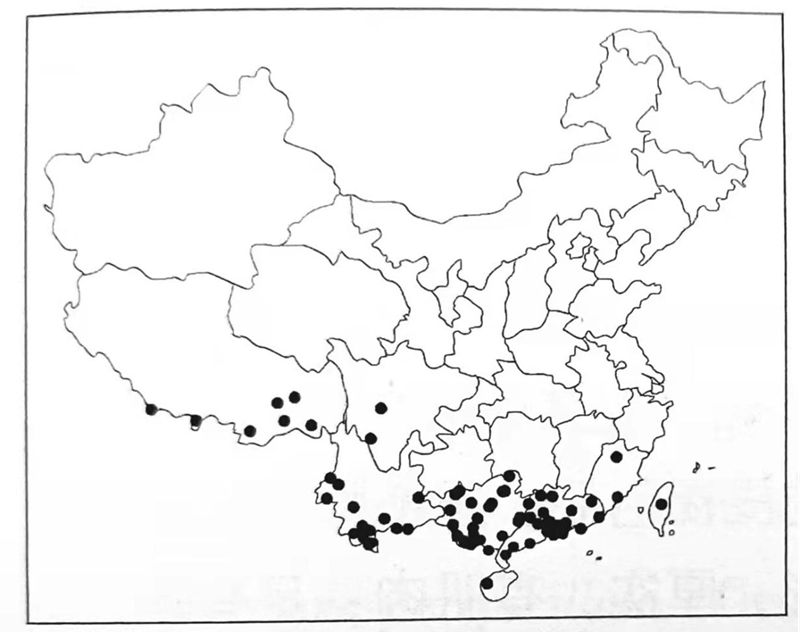
图8. 亚洲小爪水獭中国分布(来源《中国兽类野外手册》)
Figure 8. Geographic range of Asian small-clawed otter in China (origin: A Guide to the Mammals of China)
This species distributes in mainly tropical and subtropical areas of Asia, including South and Southeast Asia, and extending to the southern foothills of the Himalayas and south China.
Distribution countries: China, Nepal, Bhutan, Bangladesh, India, Laos, Myanmar, Cambodia, Vietnam, Thailand, Malaysia, Singapore, Philippines, Brunei, Indonesia (Fig. 7).
Distribution in China: the small-clawed otter was once widely distributed in many provinces and regions in south and southwest China, including Fujian, Guangdong, Guangxi, Guizhou, Yunnan, Sichuan, Xizang, Hainan and Taiwan (Fig. 8), but only a few locations in western Yunnan have been confirmed in recent years.
5. 栖息环境Habitat
适应半水生生活,栖息在多种湿地系统中,包括溪流、水塘、水田、沼泽和红树林等;更偏向于流动缓慢或静止、浅、面积较小的水体。
分布海拔高度可达2000米。
有时会和欧亚水獭和江獭同域分布,但相比较其它物种而言,小爪水獭更喜欢小型的水体。且捕食的主要食物物种不同,江獭主要捕食体型比较大的鱼类,欧亚水獭捕食小型鱼类和蛙类,小爪水獭则主要捕食淡水蟹类。
小爪水獭不喜欢完全裸露,没有遮蔽的环境。
Small-clawed otters are adapted to semi-aquatic life, living in a variety of wetland systems, including streams, ponds, paddy fields, marshes and mangroves; They prefer slow-flowing or static, shallow and small water bodies.
The distribution altitude can reach 2000 meters.
They are sometimes sympatric with Eurasian otters and smooth-coated otters, but the small-clawed otter prefers small bodies of water. And their main food species are different. Smooth-coated otters mainly prey on large fish, Eurasian otter on small fish and frogs, and small-clawed otter on freshwater crabs.
Small-clawed otters don't like completely naked and unprotected habitats.
6. 生活习性Ecology
6.1 食物Food Habits
小爪水獭是肉食动物,主要以水生动物为食,食物多样性高,包括淡水螃蟹、小型鱼类、螺类、贝类、两栖类(蛙类等)、昆虫、爬行类(蜥蜴、蛇等)、鸟类。
在许多区域,其主要食物都是淡水螃蟹。但有一些地区可能因为蟹类的数量不多,它们的主要食物会有所变化。不同地区的小爪水獭食物组成可能不同,作为机会主义捕食者,它们会根据食物获取的难易程度进行捕食。
小爪水獭使用前爪捕食。
它们会将贝类动物移至太阳下暴晒等贝壳张开以后再吃。
Small-clawed otters are carnivores, feeding mainly on aquatic animals. Their forage a high diversity of food, including freshwater crabs, small fish, snails, shellfish, amphibians (frogs, etc.), insects, reptiles (lizards, snakes, etc.) and birds.
In many areas, their main food is freshwater crabs. But there may be some areas where the crab density is low and their diet may change. Small-clawed otters may have different food compositions in different regions, and as opportunistic predators, small-clawed otters will choose preys according to their availability.
Small-clawed otters hunt with their front paws.
They will put the shellfish under the sun and wait for the shells to open before eating them.
6.2 社群Sociality
高度群居型动物,常见4-12只聚集,数量多时可见12-15只聚集在一起集群觅食。这些群体由一对优势雌性和优势雄性和它们连续生下的几窝后代组成。
它们像鸟一样的吱吱声帮助它们在野外找到对方,但它们的社交词汇远不止于此,它们已经发展了12种或更多不同的呼唤。
Small-clawed otter are highly social animals. The group size is usually 4-12, and sometimes 12-15 individuals gather together to forage. These groups consist of a pair of dominant females and dominant males and their successive litters of offspring.
Their bird-like squeaks help them find each other in wild, but their social vocabulary goes far beyond that and they have developed a dozen or more different types of calls.
6.3 领域Home Range
小爪水獭会有规律地用气味标记不同的领地。
Small-clawed otters use regular scent-marks to mark different territory.
6.4 节律Rhythm
主要在白天和晨昏活动。
They are active at sunrise and sunset.
7. 繁殖
一夫一妻制,成对生活。
雌性发情周期从28天到30天不等,一年之中任意时间都可繁殖。一些圈养机构发现年龄较大的个体每过几个月就会发情。发情持续1至13天。发情的迹象可能包括摩擦和标记的增加。
在圈养环境中,交配通常发生在水中,但有时也会在岸上。
孕期60天。成年雌性每年可繁殖2胎,每一胎幼崽的数量为2-7只,平均4-5只。
通常父母双方都会抚养幼崽。但是,与欧亚水獭不同,它们不太擅长养育这些幼崽。幼崽跟父母共同生活一年多后,加入与它无亲缘关系的群体。2.5岁时可性成熟。
圈养个体的寿命约为11年。
Small-clawed otters are monogamy, which live in pairs.
Female estrus cycles range from 28 to 30 days and can reproduce at any time of the year. Some captive facilities find that older individuals become estrus every few months. Estrus lasts 1 to 13 days. Signs of estrus may include rubbing and increased marking.
In captivity, mating usually takes place in water, but sometimes also onshore.
Gestation lasts 60 days. Adult females can give birth to two cubs per year, with a litter size of two to seven and an average of four to five.
Usually both parents participate in raising the young. But, unlike Eurasian otters, they're not very good at that. After living with their parents for more than a year, the cubs join unrelated groups. Sexual maturity occurs at 2.5 years of age.
The lifespan of an individual in captivity is about 11 years.
8. 生态系统中作用Ecosystem Role
湿地指海洋和内陆常年有浅层积水或土壤过湿的地段。众所周知,湿地是生物多样性和经济价值最高的栖息地之一,但它们仍在继续减少。实际上,据估计,自工业化时代以来,全世界湿地的减少幅度高达87%。人类对湿地的使用会对生物多样性产生严重影响。
水獭是同时使用陆地和水生环境的捕食者(图9),其损失对当地食物网、生物多样性和栖息地关系会造成严重影响。
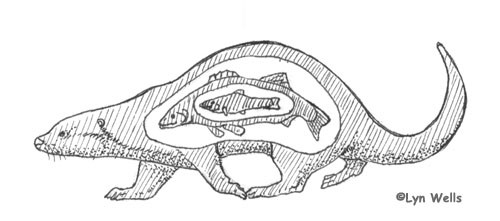
图9. 水獭是捕食者(作者Lyn Wells)
Figure 9. Otters as predators (Contributor: Lyn Wells )
水獭生活在许多不同的水生环境中:沿海、河口、河流、湖泊、运河、沼泽等。它们需要良好的水质以及无污染的自然土地栖息地。这对于包括我们自己在内的所有物种都是必不可少的,因此它们是出色的环境指标物种。
The wetlands refer to areas of the sea and the inland with perennial shallow water or soil wet. It is well known that wetlands are one of the most valuable habitats of biodiversity and economic value, but they are still declining. In fact, it is estimated that since the industrialization era, the extent of the world's wetlands has been reduced by up to 87%. Human use of wetlands can have a serious impact on the diversity of life.
Otters are predators (Fig. 9) who use both land and aquatic environments , which can have an important impact on food nets, biodiversity and habitat.
Otters live in many different aquatic environments: coast, estuaries, rivers, lakes, canals, marshes, etc. They need good water quality and unpolluted natural land habitat. These are essential for all species, including human, so they are excellent environmental indicator species.
9. 保护现状Conservation Status
小爪水獭的生存面临着多种威胁,如被捕捉成为活体宠物、获取皮毛,还有栖息地破坏。面临诸多威胁,小爪水獭的种群数量正在下降。
其实不仅是小爪水獭,世界上有13种水獭,在南极和大洋洲以外的所有大洲都发现有水獭。它们都在受威胁物种红色名录中。除了北美水獭的数量能保持稳定,其它所有水獭物种的数量均在下降。然而,即使这样,北美水獭的种群数量趋势也令人质疑,因为每年有成千上万的个体被诱捕而合法杀死。
在过去,水獭的生存存在许多问题,包括狩猎毛皮和污染。以欧亚水獭为例:
直到20世纪中叶,人们才意识到欧洲的水獭正在迅速消失,这与污染有关。各种化学药品(有机氯)被用于农业,它们正在进入环境。这些物质与多氯联苯和重金属一起不仅影响了水獭,还影响了食物链顶端的鸟类。这些化学物质甚至出现在人乳中!因此,人们开始了解维持环境质量的重要性,并开始为此做出努力。
随着欧洲水质的改善,包括水獭在内的各种物种开始恢复。但是,水獭的恢复速度并不快,因为它们繁殖缓慢且通常寿命不长。
如今,全球的水獭仍然面临许多威胁(图10):
l 污染:微塑料、化学药品泄漏、农业和工业废料、垃圾。
l 栖息地流失 :城市化进程、湿地排水、大坝建设、河岸植被清除等
l 人为干扰 :噪音增加、划船活动和采砂增加。
l 路杀 :许多水獭在试图回家的路上死于道路上。
l 与渔业的竞争 :水獭同渔业的竞争可能导致狩猎水獭,然后成为非法野生动植物贸易的来源。在某些国家或地区,例如奥地利,目前已批准使用合法的水獭捕捉工具。
l 诱捕 :水獭在许多国家或地区都受到法律保护,但在北美,有50,000只水獭被诱捕合法杀死。
l 非法贸易 :毛皮和宠物。

图10. 水獭面临的多种威胁
Figure 10. Multiple threats faced by otters
Small-clawed otters’ survival faces multiple threats, including capture as live pets, fur harvesting, and habitat destruction. In the face of many threats, the population number of small-clawed otter is declining.
In fact, it's not just the small-clawed otter. There are 13 species of otter in the world, and otters are found on all continents except Antarctica and Oceania. They're all on the Red List of threatened species. With the exception of North American otter populations, whose population number has held steady, all other otter species are in decline. Even so, however, population trends of North American otters are questionable, as thousands of individuals are legally killed by trapping each year.
In the past, otters face many problems with their survival, including hunting for fur and pollution. Take the Eurasian otter as an example:
It wasn't until the middle of the 20th century that people realized that otters were disappearing rapidly from Europe, and pollution was to blame. Various chemicals (organochlorine) are used in agriculture and they are making their way into the environment. These, along with PCBS and heavy metals, affect not only otters, but also birds at the top of the food chain. These chemicals even show up in human milk! As a result, people began to understand the importance of maintaining environmental quality and began to make efforts to do so.
As water quality improved in Europe, species including otters began to recover. Otters, however, do not recover quickly because they breed slowly and usually do not live long.
Nowadays, otters around the world still face many threats (Fig. 10) :
l Pollution: microplastics, chemical leaks, agricultural and industrial waste, and garbage.
l Habitat loss: urbanization, wetland drainage, dam construction, riparian vegetation removal, etc
l Human interference: noise increases, boating activity increases, and sand mining increases.
l Load kill: many otters die on the roads trying to get home.
l Competition against fishing: Competition between otters and fishing can lead to otter hunting, which in turn becomes a source of illegal wildlife trade. In some countries or areas, such as Austria, the use of legal otter trapping tools is now approved.
l Trappings: Otters are protected by law in many countries and regions, but 50,000 otters are legally killed by snares in North America.
l Illegal trade: fur and pets.
参考文献References
CRANDALL L S. The Management of Wild Animals in Captivity. [M]. Chicago, USA: University of Chicago Press, 1964.
FOSTER-TURLEY P, ENGFER S. The species survival plan for the Asian Small-clawed Otter, Aonyx cinerea[J]. International Zoo Yearbook, 1988, 27: 79-84.
KRUUK H, KANCHANASAKA B, O'SULLIVIAN S, et al. Niche separation in three sympatric otters Lutra perspicillata, Lutra lutra and Aonyx cinerea in Huai Kha Khaeng, Thailand[J]. Biological Conservation, 1994: 115-210.
LANCASTER W E. Exhibiting and breeding the Asian small-clawed otter at Adelaide Zoo[J]. International Zoo Yearbook, 1975, 15: 63-65.
MELISCH R, KUSUMAWARDHANI L, ASMORO P B, et al. The otters of west Java - a survey of their distribution and habitat use and a strategy towards a species conservation programme. PHPA/Wetlands International – Indonesia Programme, Bogor, Indonesia[R]. 1996,pages.
SMITH A T, 解焱. 中国兽类野外手册[M]. 长沙: 湖南教育出版社, 2009.
WRIGHT L, DE SILVA P, CHAN B, et al. Aonyx cinereus. The IUCN Red List of Threatened Species 2015[EB/OL]. 2014. https://dx.doi.org/10.2305/IUCN.UK.2015-2.RLTS.T44166A21939068.en
国家林业和草原局/国家公园管理局. 国家重点保护野生动物名录[EB/OL]. 2021. http://www.forestry.gov.cn/html/main/main3954/20210225160347342521589/file/20210225160401102702964.pdf
刘少英, 吴毅. 中国兽类图鉴[M]. 福州: 海峡书局, 2019.
朱立春. 动物世界[M]. 北京: 中国华侨出版社, 2010.